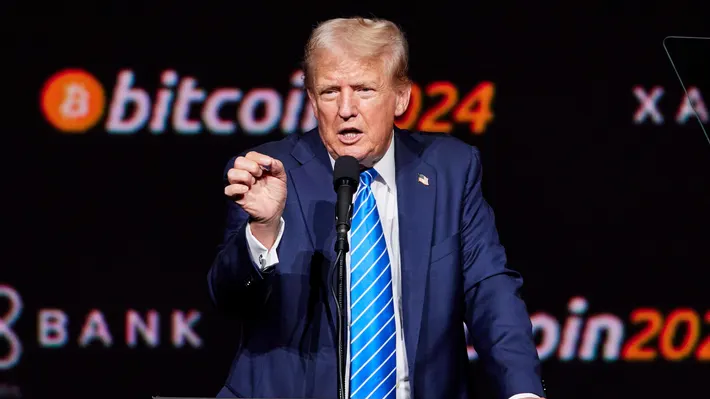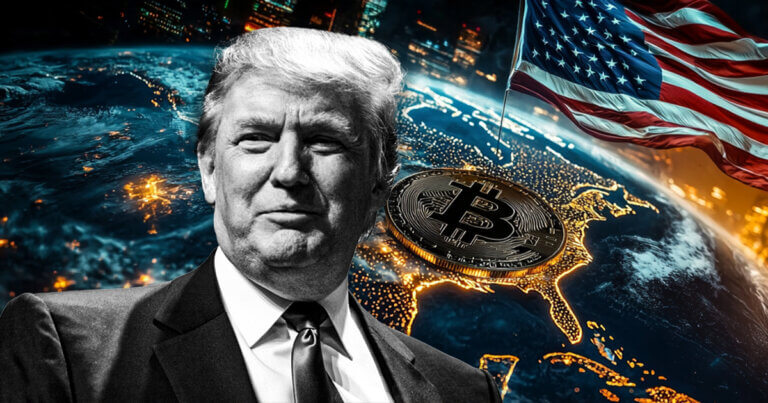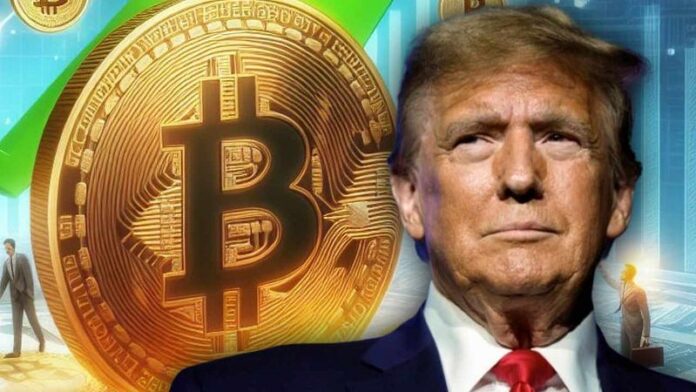As speculation mounts regarding a Trump administration plan for the U.S. government to accumulate one million Bitcoin as a reserve asset, the crypto community and financial markets are abuzz.
This potential strategy would be unprecedented in modern monetary policy, positioning Bitcoin alongside gold and U.S. Treasury securities as a significant national reserve asset. With the supply of Bitcoin capped at 21 million, such a bold accumulation would represent nearly 5% of the total Bitcoin that will ever be mined, profoundly impacting its market dynamics. Here’s an analysis of the potential implications of such a strategy, conservative price projections for Bitcoin over the next one to five years, and the broader macroeconomic effects.
Why Would the U.S. Consider Bitcoin as a Reserve Asset?
There are several strategic motivations behind the U.S. potentially holding Bitcoin as a reserve:
- Hedge Against Inflation and Currency Devaluation: As central banks worldwide print more fiat currency, Bitcoin’s fixed supply and decentralized nature make it an attractive hedge against inflation.
- Competitive Advantage in the Digital Economy: With increasing institutional acceptance of Bitcoin and digital assets, the U.S. could establish itself as a leader in the new digital financial era by holding significant Bitcoin reserves.
- Strengthening Economic Sovereignty: Bitcoin is a decentralized asset, unbound by any single economy or geopolitical entity. Holding it as a reserve would offer the U.S. independence from potential fiat currency disruptions.
 Impact on Bitcoin Price
Impact on Bitcoin Price
Accumulating one million Bitcoin—about 5% of the total supply and an estimated 25% of Bitcoin’s current circulating supply—would place significant pressure on its already limited liquidity. This move could set off a supply shock, with the potential to push prices up as demand overtakes the available supply. Here’s how:
- Supply Scarcity: Bitcoin’s scarcity is its defining feature. With 18.7 million already mined, approximately 3 million Bitcoin remain to be mined over the next 120 years. The U.S. purchasing one million Bitcoin could strain available supplies for retail and institutional investors, causing an increase in price as demand outpaces availability.
- Institutional Confidence Boost: A government Bitcoin buy-in would validate the asset in the eyes of many traditional institutions still cautious about digital assets. Increased confidence and mainstream adoption could lead to even greater demand among corporations, investment funds, and individual investors.
- Geopolitical Ripple Effects: Other governments may follow suit, further tightening Bitcoin’s available supply. Countries like China and Russia could initiate similar Bitcoin purchasing plans as a counterbalance, creating competition among governments.
Price Projections: Conservative Scenarios for Bitcoin’s Next Five Years
Given this potential shift in U.S. policy, let’s look at some conservative price projections:
- 1-Year Projection (2025):
Should the U.S. announce and begin executing this plan, Bitcoin could reach a conservative price of $75,000 to $100,000 within a year. This estimate assumes that increased government interest will attract other investors while avoiding a full-on speculative bubble. - 3-Year Projection (2027):
Over three years, with ongoing U.S. accumulation and sustained institutional adoption, Bitcoin’s price could rise to $125,000 to $200,000. The effects of this demand, paired with Bitcoin’s limited supply, would likely keep upward pressure on the price, although this period could also see some volatility as the market adjusts to this new equilibrium. - 5-Year Projection (2029):
By 2029, if the U.S. reaches its goal of holding one million Bitcoin and the move triggers a cascade of global reserve adoption, Bitcoin could realistically be valued between $250,000 and $500,000. However, these projections hinge on several factors, including continued institutional trust, government regulations, and market adoption.
Potential Risks and Market Dynamics
- Volatility: Bitcoin remains highly volatile, and while government accumulation could increase its value, it might also attract speculative activity, leading to price swings that could discourage retail investors.
- Geopolitical and Regulatory Pressures: Bitcoin’s decentralized nature could pose challenges for governments seeking control over digital assets. Should regulations become too strict, it could hinder its adoption and price growth.
- Alternative Reserve Assets: If other digital assets or government-backed digital currencies (CBDCs) emerge as reserve options, Bitcoin’s position could face competition, impacting its projected growth.
Broader Implications for the Economy and Financial Markets
The potential U.S. government accumulation of Bitcoin would mark a paradigm shift in financial markets and monetary policy. This move would not only validate Bitcoin as a legitimate reserve asset but could also signal the start of a broader transition to digital assets among global governments. Such a shift would encourage innovation in digital finance and potentially weaken the U.S. dollar’s monopoly on international trade.
On a macroeconomic level, Bitcoin’s inclusion in the national reserve could give the U.S. a hedge against fiat currency inflation while also positioning it as a leader in digital assets, a domain gaining global prominence. Yet, the decision could create challenges, especially if Bitcoin’s price becomes overly volatile or if other governments attempt to counterbalance the move by accumulating Bitcoin themselves.
Conclusion
A U.S. government Bitcoin reserve strategy could be a game-changer, sparking increased confidence in Bitcoin as a mainstream financial asset and fueling unprecedented demand. Over the next five years, such a policy could lead to significant price appreciation, albeit with the risks associated with market volatility and global competition.
As the cryptocurrency world anticipates these developments, Bitcoin’s journey from a fringe asset to a potential global reserve currency could fundamentally reshape the financial landscape in ways that remain both unpredictable and immensely exciting.
 Sources
Sources
Currently, there are no official announcements or concrete evidence indicating that the U.S. government plans to buy one million Bitcoin as a reserve asset. However, this topic is frequently discussed in speculative articles and by analysts examining potential government adoption of cryptocurrencies. Here are some reputable sources that cover related topics, such as cryptocurrency adoption, government interest in digital assets, and Bitcoin’s role as a reserve asset:
- CoinDesk – A leading source for news and analysis on digital assets and blockchain technology. CoinDesk often discusses trends in government interest in cryptocurrencies. Visit CoinDesk.
- Bloomberg – Known for its reliable financial reporting, Bloomberg regularly publishes insights into the impact of cryptocurrencies on global finance and potential institutional adoption. Check Bloomberg for articles on crypto trends and policies.
- The Block – This publication offers research-driven articles on crypto, including government policy and institutional perspectives. You can read about government crypto regulations and market analysis at The Block.
- Chainalysis Blog – Chainalysis is a leading blockchain analytics company. Their blog covers in-depth analyses on cryptocurrency adoption by institutions and governments, as well as market implications. Explore their insights at Chainalysis.
- U.S. Federal Reserve Reports – Although the Fed has yet to endorse Bitcoin, its reports on digital currencies and central bank digital currencies (CBDCs) provide insight into how the U.S. views the evolving digital asset landscape. Visit Federal Reserve for official releases.
For price projection models, examining Bitcoin market reports by investment firms such as ARK Invest and Fidelity can provide additional context.
#Bitcoin #Cryptocurrency #USReserve #DigitalAssets #TrumpAdministration #FinancialMarkets #BitcoinPrice #CryptoEconomy #GlobalFinance #Investment

Coach J.P. Money is the founder of Coach J.P. Money. He is an expert in Coaching and Money! He is also a writer, global citizen eco-activist, visionary, musician, artist, entertainer, businessman, investor, life coach, and syndicated columnist. He is also known as the music artist “Johnny Punish”; a name given to him by a bandmate during his Punk Rock years fronting the rogue underground punk band “Twisted Nixon”
His Expat home base since the late 1990s is Mexico. J.P. Money, aka Charles Bivona Jr., was educated at the University of Nevada Las Vegas (1980-81) and California State University Fullerton (1981-1984) with studies in accounting, finance and business. He bought is first real estate income property at 17 years old with no money down. He has been debt-free and building wealth since 1998.
Before the “internets” had been invented, he also owned and ran (5) national newspapers in the United States of America from 1987-1998. In addition, he created and ran the important online media sites; HireVeterans.com (2004-2020) and VT Foreign Policy (2004-2023).
J.P. Money is married to Queen Albertina from Sinaloa Mexico (1985). Together they have 3 adult children and 7 grandkids. They live in Baja Mexico at the home they built together out of plastic bags and dirt (Super Adobe). Now they share their epic artistic piece with the world as a unique luxury BnB called “Hacienda Eco-Domes“.
Read J.P. Money’s Full Bio at PunishStudios.com >>>












